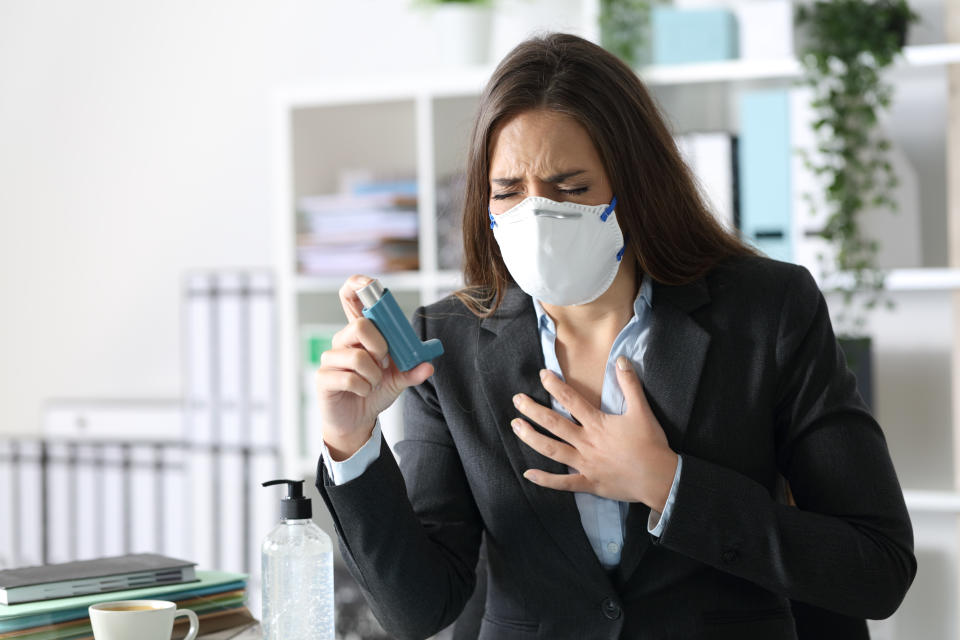Calls to allergy helpline surge as people struggle with face coverings - here's how to wear one comfortably
Face coverings are mandatory in shops and on public transport throughout much of the UK, with the rules soon to be expanded to almost all enclosed public spaces.
The coronavirus mainly spreads face to face via infectious droplets expelled in a cough or sneeze.
By enforcing coverings in enclosed spaces, officials hope to stem the spread of the virus.
Read more: Reopening schools 'may trigger second peak' if test and trace isn't improved

While experts agree the widespread use of coverings may ward off infection, Allergy UK has reported a surge in calls from people who are struggling to abide by the legislation.
Anyone with a “legitimate reason” not to wear a covering, like a physical or mental illness that impairs their ability to do so, is exempt from the rule.
A desire to help officials overcome the pandemic is said to be prompting many people with allergies to suffer in silence. An expert has therefore shared how to wear a mask comfortably.
“Wearing a mask which covers the nose and mouth may cause considerable discomfort, distress and anxiety for people living with allergic conditions such as rhinitis [inflammation of the inside of the nose due to allergens], nasal blockage or asthma, and itchy skin conditions which may affect the face, such as atopic eczema and urticaria [hives],” Amena Warner from Allergy UK told Yahoo UK.
More than one in five people in the UK have at least one allergic disorder.
Hay fever is among the most common complaint, affecting up to three in 10 (30%) adults and as many as two in five (40%) children.
This tends to be worst in summer, with grass pollen – the biggest offender – being released between May and July. While weed pollen is released from June to September.
Read more: Two in five with a lung condition will shield until there is a vaccine

Speaking of those who called Allergy UK’s helpline, Warner said: “Their nose was so blocked and stuffy, they were dependent on breathing through their mouth.
“Because they can’t breathe at all from their nose [and are] trying to breathe through their mouth, they feel like they can’t get enough air in [when wearing a covering].”
One in 11 children and one in 12 adults in the UK are also on asthma treatment.
“If you have breathing problems anyway, to have that air flow restricted even more [by a covering] is difficult,” said Warner.
“Some may feel very claustrophobic.”
People who frequently come out in hives, due to the non-serious condition dermatographism, may also be concerned their face will flare-up.
“Some worry the masks, because of the anxiety of wearing them and feeling claustrophobic, would cause hives on their face,” said Warner.
Read more: Coronavirus identified six months ago - what could the next hold?
Official government guidance states anyone is unable to put on, wear or remove a face covering because of a physical or mental illness, impairment or disability is exempt from wearing one.
People who experience “severe distress” from a covering can also go without.
“The government has introduced this [legislation] to try and protect people, so those that can should,” said Warner.
“But unfortunately not everyone can. So we’re trying to balance it.”
Learning to wear a covering comfortably may be particularly important as the government expands where they are enforced.
From 8 August, they will be required in cinemas, hotels and places of worship in England, to name a few.
How to be comfortable in a face covering
Different people may experience varying levels of discomfort depending on the material their covering is made from.
Allergy UK – which has partnered with Kleenex – recommends experimenting with different types to see which you find most comfortable, for example those secured with elastic loops around the ears versus ties.
Warner cautions, however: “Not everyone is financially in a position to try different masks until they find the right one for them [and] once you purchase a mask, you can’t take it back.”
For those who have already invested in a covering, she advises wearing it “mainly when in close proximity to others outside of your close family or friend network, and where there may be most risk, for example on public transport”.
“Short periods where there is most risk is preferable to not wearing one at all,” added Warner.
If face coverings make you anxious, practice wearing one in your home or an open space, where they are not enforced, she said.
For those who find coverings uncomfortable, try and position it so it does not rub against your ears.
Allergy UK recommends sewing buttons on a headband that the straps can go around.
Glasses-wearers may find coverings cause them to fog up. To help prevent this, choose masks with a nose clip or adjustable bridge to close the gap above the nose, preventing air reaching the glasses.



